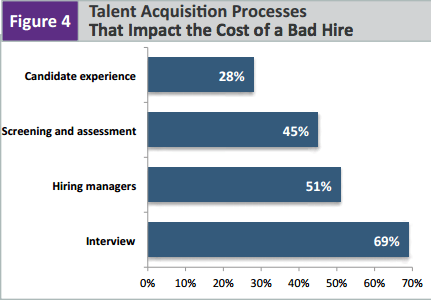7 Interview Mistakes Every Employer Makes
As globalization continues to spread and companies continue to expand and compete on a larger scale, there is an ever-increasing need to fill positions rapidly in order to achieve organizational objectives. This makes it essential for employers to hire the right candidates, as not doing so can have a detrimental impact. In fact, according to Brandon Hall Group’s Talent Acquisition Study, 95% of organizations of all sizes admit to making bad hires every year. Bad hires can negatively impact productivity, performance, retention and culture.
While it is difficult to arrive at an exact figure for the cost of a bad loss, SHRM estimate that it can cost up to fives times the person’s annual salary which can be even higher depending on the person’s tenure and seniority. Another noteworthy finding is that 69% of the companies surveyed identified the interview process as having the greatest impact on the quality of the hire. This means employers need to optimize their interview process so that they can not only improve productivity and performance, but save costs as well.
So what are recruiters and hiring managers doing in interviews that produce these poor results? We explore the top 7 common mistakes interviewers make in the hiring process:
1. Unstructured Interviews
At the most basic level, there are two types of interviews: structured and unstructured. Structured interviews have job-related questions and factors evaluated are explicit and are the same for each candidate. For unstructured interviews, all questions wouldn’t necessarily be job-related and the factors evaluated are implicit and vary across candidates. This doesn’t make for a consistent format as the candidates are not evaluated equally which can prove costly when a decision has to be made. With structured interviews, candidates get asked the same questions for the same job and there is a pre-developed system for evaluating results which allows organizations to better determine which candidates are the best fit.
2. Standard Questions
While it is important to ask the same or very similar questions of the candidate, it is also just as important not to default back to the standard interview questions that candidates can always prepare for. There are millions of articles online about the most common interview questions that candidates can view and start to prepare rehearsed answers for. Interviewers can turn this process on its head, whereby they put in the time to prepare in-depth questions that will give them a better indication of the qualities of the candidate. Try your best to steer clear of boring questions like “Walk me through your resume”, “Tell me about yourself” and “What are your strengths and weaknesses?”. Instead, go for something like “Tell me about a time you had to manage a difficult project. How did you approach? What was the end result?”
3. Recency and Primacy Bias
Bias is continuing to plague companies in the interview process. Two very important bias factors that have received a lot of attention is recency and primacy bias. Recency bias occurs when a recruiter/hiring manager is more affected by the most recent candidates in the interview process, whereas primacy bias occurs when a recruiter/hiring manager makes a decision based on information from earlier candidates. In short and complex interviews, interviewers tend to make their decisions based on the most recent candidates (recency). In contrast, when an interview is particularly long, interviewers become mentally tired and rely on their first impressions to make a decision (primacy).
To try your best to avoid these types of bias, there are a number of things you can do such as:
- Recording interviews so you can refer back to them for evaluation.
- Taking plenty of notes at each interview, going over them after the interview and, going over them again when it comes to the final decision.
- Create a rating system for the core competencies of the job for all candidates in order to evaluate the most relevant skills objectively.
4. Talking Too Much
What really makes an interview successful for both parties is the mutual exchange of information. On too many occasions, interviewers can talk too much about themselves, what their role is and what their background is and how great the company is. At the end of interview, the interviewer has actually very little information on which to base their decision on. While the candidate is well-informed about the interviewer’s professional life, the culture of the organization, and the composition of the team, the interviewer does not know much about the candidate’s skills, experience or personality. Encourage the candidate to talk as much as possible, while also giving a brief overview of your company. It’s a two-way street; don’t break the law!

5. Incoherent Recruiting Team
Chances are that the position you are trying to fill will require multiple interviews. This means there will be a number of people involved e.g the recruiter, supervisor, manager, and director can all be conducting interviews for a particular position at different stages. Without sufficient communication, inconsistencies can arise in terms of the questions being asked, failing to explain the job requirements etc. A standard strategy needs to be put in place so internal stakeholders are not making ad-hoc decisions but instead taking the time to evaluate the previous interview stages and shaping new questions around that.
6. Trusting First Impressions
It is important not to make your hiring decision based on your first impression of the candidate. Employers frequently view the suitability of potential candidates in terms of whether or not they ‘like’ them without focusing on their actual strengths which can prove costly later on if that person is hired. Positive body language like a firm handshake and good eye contact, while appreciated, should not be considered major contributors to the final decision.
Jason Berkowitz, former Business Development Executive of IBM Global Process Services, says “Don’t use the interview to try to validate a good or bad snap judgement [of a candidate]. Hiring managers should actually try to disprove their initial impression. If you like someone off the bat, look for reasons they aren’t right for the job. If you dislike someone, look for reasons why they are right for the job”.
7. Exaggerating the Role
It can be tempting for interviewers to exaggerate the positive aspects of the role in order to make the recruiting process quicker. However, candidates will accept jobs based on the information that is given to them and if they find that much of this information has been tweaked in order to make the job sound more attractive, they will be extremely disappointed. This can lead to the lower performance levels and productivity as discussed above. While there is an element of ‘selling’ a job to a potential candidate, being transparent is key so that the candidate has clear idea of exactly what the role is about.
Looking to take your interviews to the next level? Check out SocialTalent’s dedicated Interviewing Training Solution.


